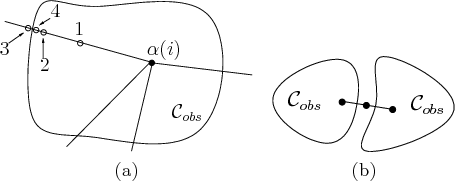
Next: Sampling on the boundary Up: 5.6.3 Heuristics for Improving Previous: 5.6.3 Heuristics for Improving
This heuristic strategy focuses effort on vertices that were difficult
to connect to other vertices in the roadmap construction algorithm in
Figure 5.25. A probability distribution, ![]() , is defined
over the vertices
, is defined
over the vertices ![]() . A number of iterations are then
performed in which a vertex is sampled from
. A number of iterations are then
performed in which a vertex is sampled from ![]() according to
according to ![]() ,
and then some random motions are performed from
,
and then some random motions are performed from ![]() to try to reach
new configurations. These new configurations are added as vertices,
and attempts are made to connect them to other vertices, as selected
by the NEIGHBORHOOD function in an ordinary iteration of the
algorithm in Figure 5.25. A recommended heuristic
[516] for defining
to try to reach
new configurations. These new configurations are added as vertices,
and attempts are made to connect them to other vertices, as selected
by the NEIGHBORHOOD function in an ordinary iteration of the
algorithm in Figure 5.25. A recommended heuristic
[516] for defining ![]() is to define a statistic for
each
is to define a statistic for
each ![]() as
as
![]() , in which
, in which ![]() is the total number of
connections attempted for
is the total number of
connections attempted for ![]() , and
, and ![]() is the number of times these
attempts failed. The probability
is the number of times these
attempts failed. The probability ![]() is assigned as
is assigned as
![]() , in which
, in which ![]() is the sum of the statistics over all
is the sum of the statistics over all ![]() (this
normalizes the statistics to obtain a valid probability
distribution).
(this
normalizes the statistics to obtain a valid probability
distribution).
 |
Steven M LaValle 2012-04-20